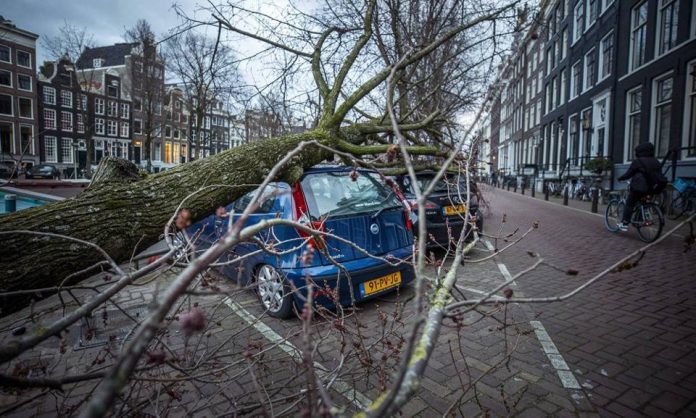
LONDON, Feb 20, 2022: Emergency crews Saturday battled to
restore power to more than one million homes and businesses a day after Storm
Eunice carved a deadly trail across northwest Europe and left transport
networks in disarray.
At least 16 people were killed by falling trees and flying debris caused
by the fierce winds in Britain, Ireland, the Netherlands, Belgium, Germany
and Poland, emergency services said.
Train operators in Britain urged people not to travel, after most of the
network was shut down when Eunice brought the strongest wind gust ever
recorded in England — 122 miles (196 kilometres) per hour.
In Brentwood, east of London, a 400-year-old tree crashed into a house
where Sven Good was working from home, as millions of other Britons heeded
government advice to stay indoors.
“I could feel the whole roof going above me. It was absolutely
terrifying,” Good, 23, told Sky News, adding that none of the occupants was
injured.
The train network in the Netherlands was paralysed, with no Eurostar and
Thalys international services running from Britain and France after damage to
overhead power lines.
France and Ireland were also grappling with rail disruption and power
cuts, and Germany’s rail operator Deutsche Bahn said “more than 1,000
kilometres” (620 miles) of track had suffered damage.
– Explosive storms –
Poland still had 1.2 million customers without electricity on Saturday
afternoon, officials said, after the country’s northwest took a battering.
“I appeal to you: please stay at home!” Polish Prime Minister Mateusz
Morawiecki said in a Facebook post.
“We are constantly monitoring the situation and the appropriate services
are at work. The fire brigade has already intervened more than 12,000 times,”
he said.
In the UK, 226,000 homes and businesses remained without power after 1.2
million others were reconnected.
The toll so far includes four each in the Netherlands and Poland; three in
the UK, two dead each in Belgium and Germany, and one in Ireland.
Around 30 people in northern France were injured in storm-related road
accidents, and in the Netherlands, dozens of people have to be evacuated from
their homes because of fears that a church’s clock tower might collapse.
Eunice sparked the first-ever “red” weather warning for London on Friday.
It was one of the most powerful tempests in Europe since the “Great Storm”
hit Britain and northern France in 1987.
Scientists said both storms packed a “sting jet”, a rarely seen
meteorological phenomenon borne out of an unusual confluence of pressure
systems in the Atlantic that magnified the effects of Eunice.
– Hefty insurance bill –
The Met Office, Britain’s meteorological service, on Saturday issued a
less severe “yellow” wind warning for much of the south coast of England and
South Wales, which it said “could hamper recovery efforts from Storm Eunice”.
The UK’s total bill for damage could exceed o300 million ($410 million,
360 million euros), according to the Association of British Insurers, based
on repairs from previous storms.
At the storm’s height, planes struggled to land in ferocious winds, as
documented by the YouTube channel Big Jet TV, which streamed the attempts to
a mass live following from London’s Heathrow airport.
Hundreds of other flights were cancelled or delayed at Heathrow and
Gatwick, and Schiphol in Amsterdam.
A section of the roof on London’s O2 Arena was shredded, and the spire of
a church in the historic city of Wells, southwest England, toppled over.
Ferries across the Channel, the world’s busiest shipping lane, were
suspended, before the English port of Dover reopened Friday afternoon.
Experts said the frequency and intensity of the storms could not be linked
necessarily to climate change.
But Richard Allan, professor of climate science at the University of
Reading, said a heating planet was leading to more intense rainfall and
higher sea levels. Therefore, he said, “flooding from coastal storm surges
and prolonged deluges will worsen still further when these rare, explosive
storms hit us in a warmer world”.
Source: (BSS/AFP)









